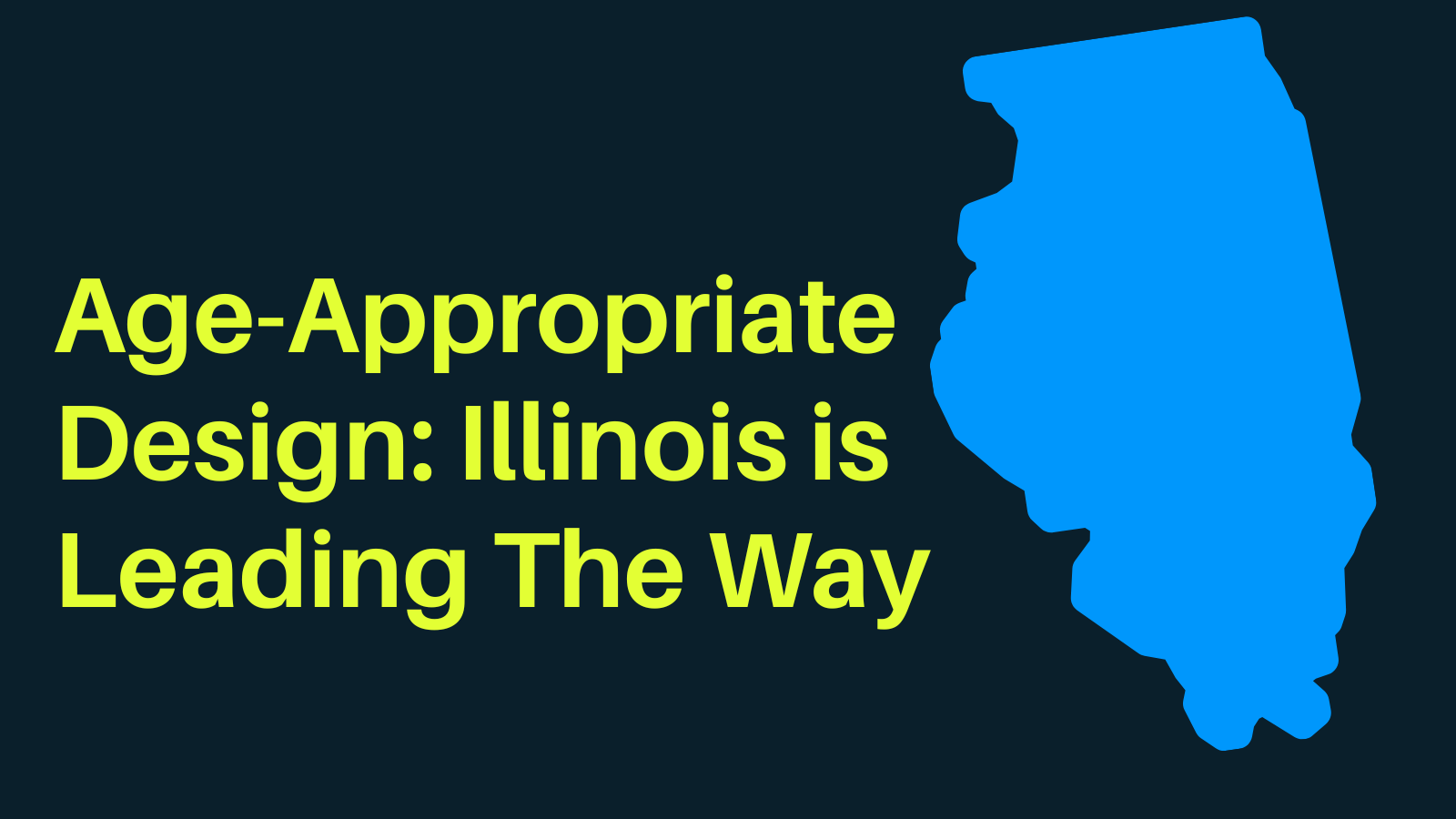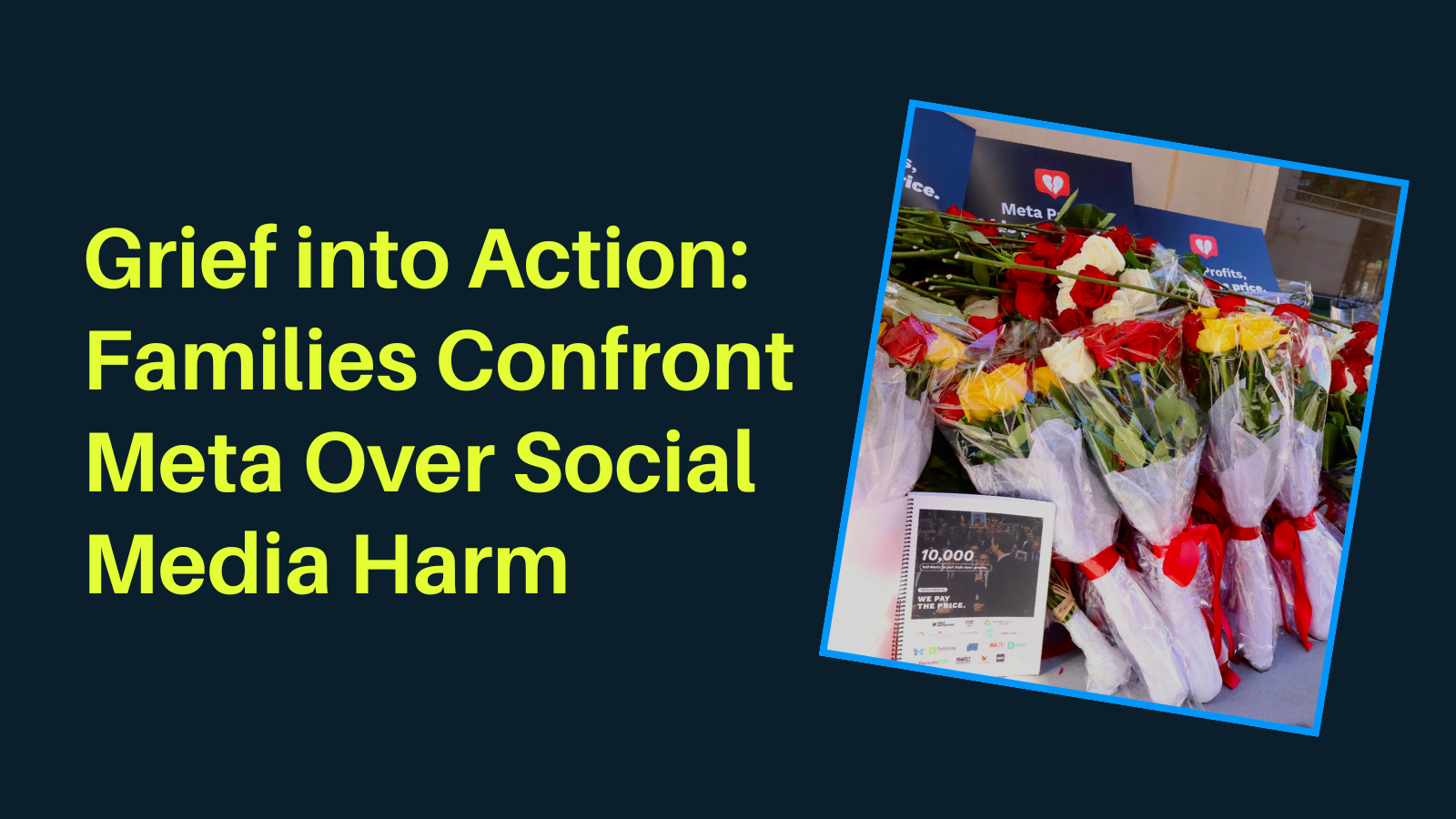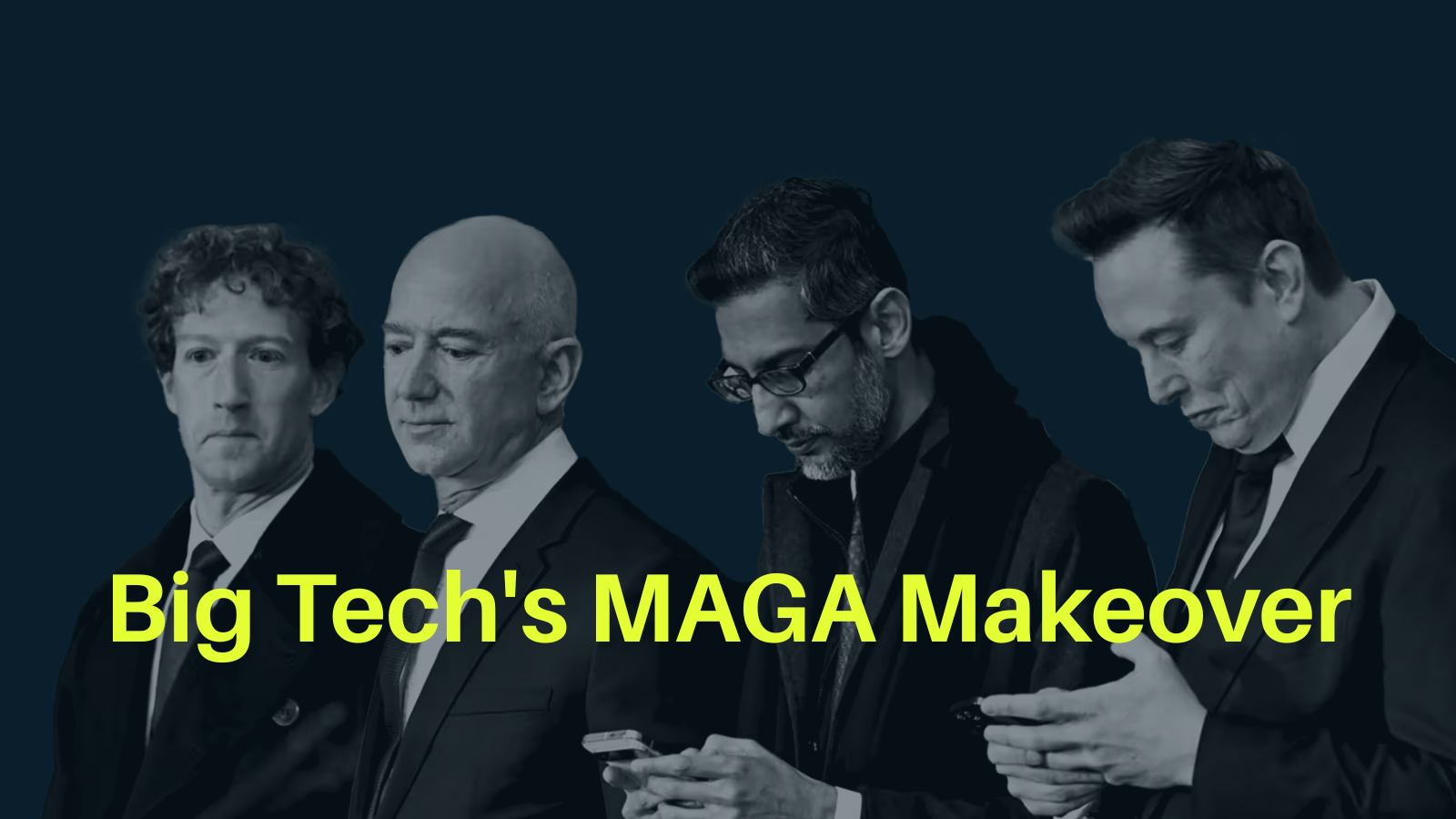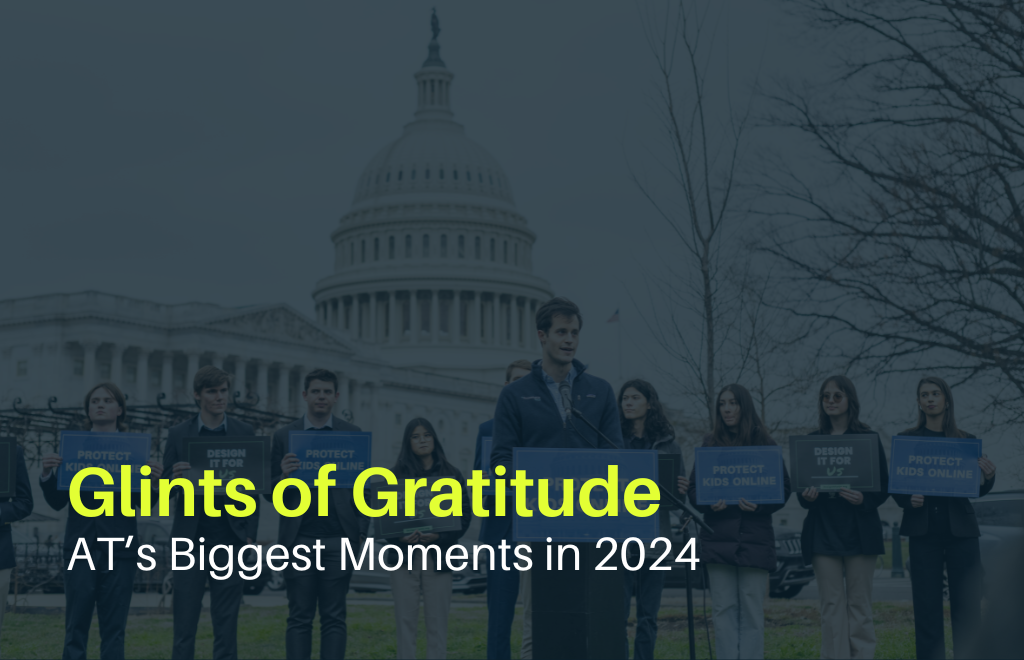Accountable Tech and Design It For Us have worked to pass the Age-Appropriate Design Codes in Illinois and Vermont this year. Zamaan Qureshi sat down with Isabel Sunderland, an Organizing Director for State and Federal Lobbying with Design It For Us, to discuss kids’ online safety and privacy and their work on the IL AADC. Isabel also has a wealth of experience in this area as a Technology Reform Policy Associate with Issue One, a cross-partisan political reform group. The transcribed conversation is below:
Zamaan Qureshi:
Isabel Sunderland, thanks so much for sitting down with me at Accountable Tech here to talk a little bit about the Age-Appropriate Design Code and specifically the work that you and I have had the privilege of doing together on the Illinois Age-Appropriate Design Code. I know it’s early stages, and there’s still a lot moving around the kids’ online safety and privacy space, but your work throughout Design It For Us has been integral to this space, and I wanted to get the chance to sit down with you and hear a little bit of your perspective. So my first question is, Design It For Us has been involved in leading the fight for the Illinois Age-Appropriate Design Code. Why is this important to you, and what motivated you to get involved in this?
Isabel Sunderland:
That’s a great question. I think my answer would be two-fold. First is that, as you know, I’m originally from the suburbs of Chicago and Illinois, and so I think it hits a personal note for me, in that having grown up in the state, I still having friends, family, cousins, still living there, and also witnessing firsthand the impact that social media has had on my generation and that will also be having on this coming generation. I think it’s a powerful message to be able to send that, “hey, we’re working to pass legislation that will finally hold these tech companies accountable,” and better yet, it’s going to impact my own family and friends and people that I know still in the state.
And I think the second fold of my answer as well is just the fact that we know that, I think the original date is 1998, when any kind of federal legislation was passed to regulate these Big Tech platforms. My favorite statistic is that 1998 was when Mark Zuckerberg was 13 or 14 years old, and so he would have been signing up for his first social media platform at that age as well. And yet, we’ve also seen that the way that this technology has changed over the past 2 decades has been so dramatic, and that policy and safeguards need to keep up with that change as well.
Zamaan Qureshi:
Yeah, you’re exactly right. Our experiences closely mirror one another, having grown up in the same area, and so I certainly remember seeing those harms taking place within our generation, with our peer group.
I don’t know if this is the case for you, but it wasn’t until I was older that I started to look back and think about, this happened, or that happened, either in my own life or with my peers of like well, that was harmful social media playing a really pivotal role in our adolescence and our upbringing. It’s certainly been interesting to reflect on that now, and I’m curious, like those experiences that you have seen firsthand, how do you think that they should contribute to the policy-making space?
Isabel Sunderland:
Yeah, that’s a great question. I think I can answer that in a couple different ways. First, to your point, when I was growing up, my friends and I started a little meme account together on Instagram. And that demonstrates how great these social media tools can be. It really can be that connecting point. And so the message I definitely want to impress is that social media is not all bad. But, it has also been such a privilege these past couple of years to look back and see how these online tools have also transformed our personal relationships and the relationships of others as well. Social media wasn’t all good either. There was, I remember, a lot of comparison that I personally did when I looked at posts on Instagram from people.
And so personal experience can be a really guiding factor here. Every single young person should have agency to be able to learn about how these online platforms can be both positive, but also how they have these design flaws that ultimately need to be addressed. So I think personal experiences at the core and agency is the way that we affect this change.
Zamaan Qureshi:
That’s super interesting that you said that because when I testified before the Illinois legislature last week, and I know you were patiently waiting to hear our bill get called up, which ended up conflicting, but I shared a very similar experience with the committee that that kind of negative social comparison and body image comparison is so prevalent amongst our generation.
And I don’t think we talk about it enough, but it’s kind of the the the underpinning of a lot of what develops our sense of identity and who we want to be, and it can be really toxic. And I don’t think we talk about it enough in the context of the work, even that we do, because sometimes I think we’re so focused on the most tragic harms, which are absolutely should be the forefront of the conversation, but oftentimes it’s the harms that are impacting the most amount of people, but not getting the headlines that’s really harming our generation.
So yeah, I appreciate you mentioning that and bringing that up and along the same lines, this gets at why I think you and I believe in a version of age-appropriate design. What about the AADCs specifically appeals to you, especially when we’re seeing other proposals around the country pop up?
Isabel Sunderland:
Yeah, I think specific to Illinois, what I like about this version of the Age-Appropriate Design Code is that it has a lot of these really critical privacy settings on by default. I know one major thing that’s prevalent across all of these social media platforms is that I could pick up my phone right now, not be signed into Instagram, and search up any kind of person that I want to find. I can find someone from middle school, from elementary school, who I might not even have a connection with, and I’ll still be able to see their bio, their friends, their family pictures of them. And that’s something that no stranger should have the ability to do.
This is why having the highest level of privacy safeguards on by default are so essential. I think also, just speaking broadly about the Age-Appropriate Design Code model in general, the duty of care is something that’s really critical, and I know you’re super familiar with why it’s important, but just the fact that these platforms should be held responsible and accountable for the way that they’re designing their products, that’s so critical, and that’s something that’s been missing again since that 1998 date. I think those are the two things that come to mind, as some of the important provisions that are necessary for our generation, and also the generation that’s growing up now.
Zamaan Qureshi:
You mentioned the importance of the duty of care, and that’s something that you and I spend a lot of time talking and thinking about on our work around the Kids Online Safety Act, this federal legislation that would do a lot of the similar things that we’re talking about, that the Age-Appropriate Design Code would do at the state level. What are some of the lessons that you think you learned, that we learned as a community, doing that work around the Kids Online Safety Act that we can impart and take to the states, especially to Illinois, to help this bill, or bills like this, become law?
Isabel Sunderland:
Yeah, that’s a wonderful question. There are two things that come to mind. The first is on a downturn note, which is the fact that the tech lobby is so formidable and they work through civil society organizations to appear like legitimate good faith actors who want to push the legislation forward, but at the end of the day, they’re ultimately working in trade groups that are helping Big Tech. My favorite statistic to bring up is that Big Tech spent $61.5 million lobbying to kill legislation last year. We had that outstanding bipartisan 91-3 vote in the Senate last year and it wasn’t a lack of advocates or a lack of time or change that meant that the bill wasn’t ultimately voted on at the end of the year. It was the fact that tech lobbied every single member of Congress, pushing and pulling every single lever they could to try and make the argument that kids’ online safety shouldn’t be a priority. So I think that’s something that’s really critical for states to take into account. As all of these legislators are being approached by these seemingly good faith actors, there’s also an underpinning force behind it that’s working so hard to make sure that their business model isn’t going to be regulated.
But then on the more positive side of things, I think what we’ve seen a really powerful trend emerge from the KOSA movement and it’s just the overwhelming amount of youth advocates and parent advocates coming together on a single issue. I think there are so few issues that my parents and I, for example, can like agree on today, but the fact that across the spectrum, people can agree that kids online safety is something that’s of critical importance, I think, is a really powerful lesson to take away and a powerful lesson to replicate at the states as well.
Zamaan Qureshi:
Yeah, you mentioned those trade organizations. And I do wonder how the lobbyists go back to Thanksgiving dinner, for example, and say, you know, I had a really successful year. I stopped the Kids Online Safety Act from becoming law and how their relatives look at them and and, you know, wonder what it is the purpose of of these trade organizations, is, and it really is, that is to stop common-sence legislation from becoming law, because it ultimately it targets the bottom line of these companies, and that’s what they seem to fear the most, is any decrease in their profit value.
You kind of alluded to this as well, because we see so much lobbying power in both the state and the federal level amongst the tech industry. Why do you think it’s important that young people get involved in this fight around tech and tech policy?
Isabel Sunderland:
Yeah, I think it’s a matter of agency. I often feel like, as a young person, what voice do I have against a corporation that rakes in billions and millions of dollars a year and that has so much lobbying power in Congress. What voice do I have against that? But it also just takes one voice to start that machine and start working towards real reform. And so I think young people have such a powerful opportunity to take a stance, to take agency and get involved in something that’s shaping their childhood, that’s shaping their adulthood, importantly, and also shaping the adult and childhoods of their siblings and cousins and their families.
Another important note is that it also helps folks get more educated about the impact that this technology is playing as well. If I hadn’t gotten to the tech policy space by a crazy turn of events, then I would have entirely thought that the experiences I had on social media were my fault; I would have thought, “Oh, it’s my fault that I’m feeling this way. This is something that I need to fix in myself.” I’ve now had the privilege to see that that isn’t the case, and that’s not something that’s necessarily shared across my generation.
And so there’s that important piece of also having a better understanding of the ways that these really faceless corporations are shaping the way that we interact with people and shaping the way that we grow up in this world. So there’s the agency component and there’s the understanding and learning component that I think is really critical.
Zamaan Qureshi:
I fully agree with you. I think that was also one of my biggest takeaways, both it gave me some personal solace to feel like it wasn’t all my fault, and really it was because a product was made to be addictive, to keep you on the platform longer, to maximize or further the understanding of your own vulnerabilities and also, like, that’s something that I’ve tried to impart with a lot of parents who asked me what can they do? It’s been fascinating to see the push in the past, probably a year or two, around parents getting activated around this is an issue, but not knowing where to go or what to do, and I think that’s where policy plays a really critical role. We can’t put the onus all on parents or educators or young people to have to figure out this digital environment for themselves, and I think that’s why we advocate for laws, and that’s why we need laws. And as technology develops more and more and becomes much more personalized, it’s going to be that much more necessary to have policies and laws that can rein in some of these abusive practices. That’s pretty much all the questions I have. Is there anything else that you want to add to this conversation?
Isabel Sunderland:
I completely agree with everything you said. And I think it’s a testament to the fact that a year ago, we had maybe three to four Age-Appropriate Design Codes introduced across the states. And this year we see that there’s probably, like, eight or nine or 10. There’s just been a tremendous outpouring of support within this movement. There’s also the introduction of various kids safety bills across the states as well that aren’t explicitly designed codes, but do have that critical component of duty of care or highest privacy settings on by default, so it makes me feel really encouraged. I think that there are so many folks, from the teen advocate, the parent, to the people who are working in civil society, who are really pushing for this reform that it makes me really positive and hopeful about the future and definitely looking forward to continuing this fight.
Zamaan Qureshi:
Well Isabel, thanks so much for chatting with me. Thanks so much for chatting with Accountable Tech and looking forward to having this conversation out there so folks can learn about the great advocacy work that you’re doing, and that Design It For Us is doing.








